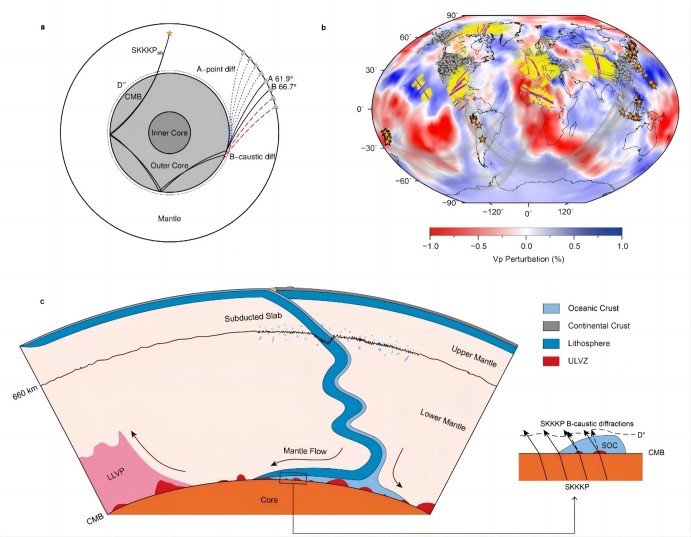
(a)The ray paths of the newly discovered SKKKP B focal phase extension and its related seismic phases
(b)The new seismic phase significantly expands the sampling area at the core-mantle boundary
(c)Schematic diagram of the formation mechanism of ultra-low velocity zones
The research team not only discovered ultra-low velocity zones around the large low-velocity provinces beneath the Pacific Ocean and Africa, but also detected ultra-low velocity zones within previously underexplored high-velocity anomaly regions at the core-mantle boundary, including regions such as Central and South America, central and western Asia, Alaska, and Greenland (Figure 1b). By combining existing geodynamic simulation results, the study revealed the formation mechanism of ultra-low velocity zones within high-velocity anomaly regions at the core-mantle boundary: when a subducting plate enters the lower mantle, its overlying oceanic crust can gradually detach and sink to the core-mantle boundary. Because the melting point of oceanic crust material is lower than that of the surrounding mantle rocks, partial melting may occur to form ultra-low velocity zones (Figure 1c).
The research was funded by the National Natural Science Foundation of China and the Strategic Priority Research Program of the Chinese Academy of Sciences. SU Yulong, a doctoral student from the University of Science and Technology of China, was the first author of the paper, and Ni Sidao, an academician from the State Key Laboratory of Geodesy and Earth's Dynamics, APM, was the corresponding author. Collaborators included the team led by Academician SUN Heping, the Woods Hole Oceanographic Institution in the United States, and scholars from Arizona State University. Based on the "Institution-Laboratory Combination" policy, the laboratory has carried out long-term close cooperation with the Earth and Space Sciences School of the University of Science and Technology of China. They have made many important progress in the study of the internal structure and dynamics of the Earth. In recent years, a series of papers published by both sides cooperate in academic journals such as Science, Nature's sub-publications, and PNAS have deepened the understanding of scientific issues such as the internal operating mechanism of the Earth.
Link to the article:https://doi.org/10.1038/s41561-024-01394-5
